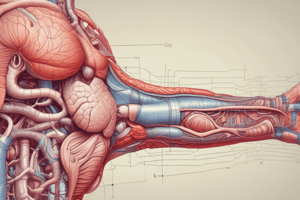Podcast
Questions and Answers
What is the primary function of bile produced by the liver?
What is the primary function of bile produced by the liver?
- Absorb water
- Regulate blood sugar levels
- Emulsify fats (correct)
- Digest proteins
Which part of the digestive system is primarily responsible for nutrient absorption?
Which part of the digestive system is primarily responsible for nutrient absorption?
- Esophagus
- Large intestine
- Stomach
- Jejunum and Ileum (correct)
Which function does the gallbladder perform in the digestive process?
Which function does the gallbladder perform in the digestive process?
- Stores and concentrates bile (correct)
- Controls blood sugar levels
- Produces digestive enzymes
- Absorbs nutrients
What is the main role of the pancreas in digestion?
What is the main role of the pancreas in digestion?
Which part of the large intestine is involved in the fermentation process?
Which part of the large intestine is involved in the fermentation process?
What occurs in the large intestine during the digestive process?
What occurs in the large intestine during the digestive process?
What structure controls the release of feces from the rectum?
What structure controls the release of feces from the rectum?
What nutrients are absorbed into the bloodstream in the small intestine?
What nutrients are absorbed into the bloodstream in the small intestine?
What is the primary role of the mouth in the digestive process?
What is the primary role of the mouth in the digestive process?
What function does the esophagus primarily serve in the digestive system?
What function does the esophagus primarily serve in the digestive system?
Which of the following correctly describes the process of peristalsis?
Which of the following correctly describes the process of peristalsis?
Which organs are classified as accessory organs in the digestive system?
Which organs are classified as accessory organs in the digestive system?
What is chyme, and when is it formed?
What is chyme, and when is it formed?
Which enzyme begins the digestion of carbohydrates in the mouth?
Which enzyme begins the digestion of carbohydrates in the mouth?
What role do gastric juices play in the stomach?
What role do gastric juices play in the stomach?
How is the small intestine structured for nutrient absorption?
How is the small intestine structured for nutrient absorption?
Flashcards are hidden until you start studying
Study Notes
Overview of the Human Digestive System
- The digestive system is a network of organs and glands responsible for breaking down food, absorbing nutrients, and eliminating waste.
- Comprises the gastrointestinal (GI) tract and accessory organs such as the liver and pancreas.
- The GI tract is a continuous tube extending from the mouth to the anus.
Components and Functions
Mouth
- Structure: Includes lips, cheeks, teeth, tongue, and salivary glands.
- Functions:
- Mechanical digestion through chewing by teeth.
- Chemical digestion initiated by saliva containing enzymes (e.g., amylase).
- Formation of bolus, a suitable mass for swallowing.
Pharynx and Esophagus
- Pharynx: Connects the mouth to the esophagus, serving as a passage for food and air.
- Esophagus: Muscular tube that transports food to the stomach via peristalsis, a rhythmic contraction process.
Stomach
- Structure: J-shaped, expandable organ in the upper abdomen.
- Functions:
- Mechanical digestion through churning mixing food with gastric juices.
- Chemical digestion facilitated by hydrochloric acid (HCl) and pepsin for protein breakdown.
- Forms chyme, a semi-liquid substance released into the small intestine.
Small Intestine
- Structure: Long, coiled tube divided into duodenum, jejunum, and ileum.
- Functions:
- Duodenum: Receives bile and pancreatic enzymes for fat and nutrient digestion.
- Jejunum and Ileum: Main sites for nutrient absorption, with an inner lining of villi and microvilli enhancing surface area.
- Absorbs amino acids, sugars, fatty acids, and vitamins into the bloodstream.
Liver
- Structure: Large organ in the upper right abdomen.
- Functions:
- Produces bile for fat digestion, stored in the gallbladder.
- Processes absorbed nutrients and detoxifies harmful substances.
- Stores vitamins and minerals, converts excess glucose to glycogen.
Gallbladder
- Structure: Small, pear-shaped organ beneath the liver.
- Function: Stores and concentrates bile, releasing it into the small intestine when needed.
Pancreas
- Structure: Gland located behind the stomach.
- Functions:
- Produces digestive enzymes (lipase, amylase, proteases) for the small intestine.
- Produces hormones (insulin, glucagon) to regulate blood sugar levels.
Large Intestine (Colon)
- Structure: Shorter and wider than the small intestine; divided into cecum, colon (ascending, transverse, descending, sigmoid), and rectum.
- Functions:
- Absorbs water and electrolytes from indigestible food.
- Compacts waste into feces.
- Houses beneficial bacteria that facilitate bacterial fermentation and produce vitamins (e.g., vitamin K).
Rectum and Anus
- Rectum: Final section of the large intestine, storing feces prior to elimination.
- Anus: Opening for feces expulsion, regulated by anal sphincters controlling release.
Studying That Suits You
Use AI to generate personalized quizzes and flashcards to suit your learning preferences.




